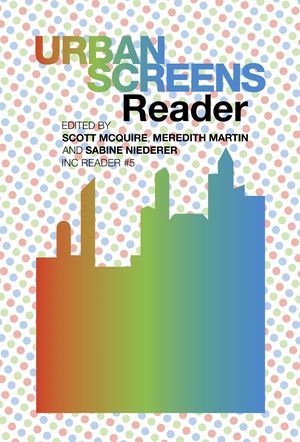Difference between revisions of "Scott McQuire, Meredith Martin, Sabine Niederer (eds.) (2009) Urban Screens"
(Página creada con «'''Scott McQuire, Meredith Martin and Sabine Niederer (2009)''.Urban Screens.''Amsterdam:Institute of Network Cultures.''' Enlace:http://networkcultures.org/blog/publicati...») |
m (Miguel moved page Scott McQuire, Meredith Martin, Sabine Niederer (2009) Urban Screens to Scott McQuire, Meredith Martin, Sabine Niederer (eds.) (2009) Urban Screens) |
||
| (3 intermediate revisions by 2 users not shown) | |||
| Line 1: | Line 1: | ||
| − | + | [[File: urban-screens-img.jpg | thumbnail | right]] | |
| − | + | == <small>'''Abstract'''</small> == | |
| − | + | The Urban Screens Reader is the first book to focus entirely on the topic of urban screens. In assembling contributions from a range of leading theorists, in conjunction with a series of case studies dealing with artists’ projects and screen operators’ and curators’ experiences, the reader offers a rich resource for those interested in the intersections between digital media, cultural practices and urban space. | |
| − | + | Urban Screens have emerged as a key site in contemporary struggles over public culture and public space. They form a strategic junction in debates over the relation between technological innovation, the digital economy, and the formation of new cultural practices in contemporary cities. How should we conceptualize public participation in relation to urban screens? Are ‘the public’ citizens, consumers, producers, or something else? Where is the public located? When a screen is erected in public space, who has access to it and control over it? What are the appropriate forms of urban planning, design and governance? How do urban screens affect cultural experiences? | |
| + | |||
| + | == <small>'''File'''</small> == | ||
| + | |||
| + | [[File: urban-screens.pdf]] | ||
| + | |||
| + | == <small>'''Source'''</small> == | ||
| + | |||
| + | [[Institute_of_Network_Cultures|Institute of Network Cultures]] | ||
| + | |||
| + | == <small>'''Links'''</small> == | ||
| + | |||
| + | '''URL:''' http://networkcultures.org/blog/publication/urban-screens/# | ||
| + | |||
| + | '''Wayback Machine:''' https://web.archive.org/web/*/http://networkcultures.org/blog/publication/urban-screens/# | ||
| − | |||
| − | [[ | + | [[Category:Library]] |
| − | [[ | + | [[Category:Institute of Network Cultures]] |
| − | [[ | + | [[Category:Scott McQuire]] |
| − | [[ | + | [[Category:Meredith Martin]] |
| − | [[ | + | [[Category:Sabine Niederer]] |
| − | [[ | + | [[Category:English]] |
| − | [[ | + | [[Category:Holland]] |
| − | [[ | + | [[Category:2009]] |
Latest revision as of 00:41, 9 May 2017
Contents
Abstract
The Urban Screens Reader is the first book to focus entirely on the topic of urban screens. In assembling contributions from a range of leading theorists, in conjunction with a series of case studies dealing with artists’ projects and screen operators’ and curators’ experiences, the reader offers a rich resource for those interested in the intersections between digital media, cultural practices and urban space.
Urban Screens have emerged as a key site in contemporary struggles over public culture and public space. They form a strategic junction in debates over the relation between technological innovation, the digital economy, and the formation of new cultural practices in contemporary cities. How should we conceptualize public participation in relation to urban screens? Are ‘the public’ citizens, consumers, producers, or something else? Where is the public located? When a screen is erected in public space, who has access to it and control over it? What are the appropriate forms of urban planning, design and governance? How do urban screens affect cultural experiences?
File
Source
Links
URL: http://networkcultures.org/blog/publication/urban-screens/#
Wayback Machine: https://web.archive.org/web/*/http://networkcultures.org/blog/publication/urban-screens/#
